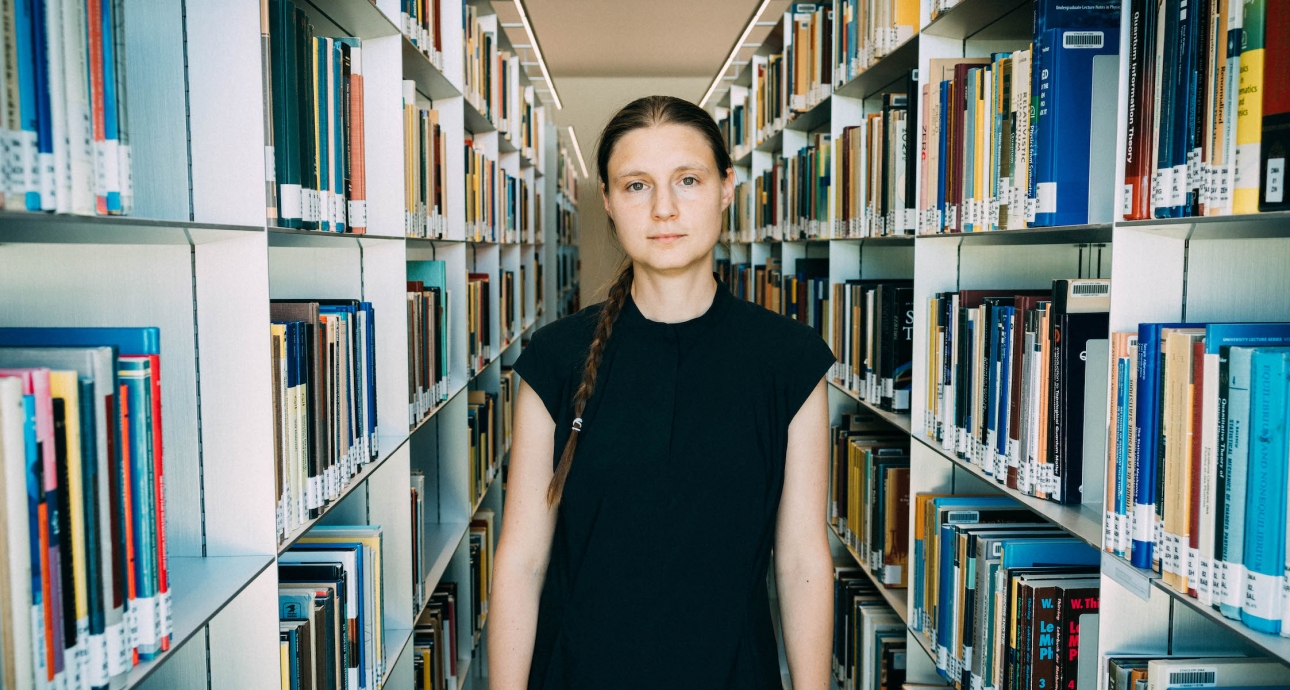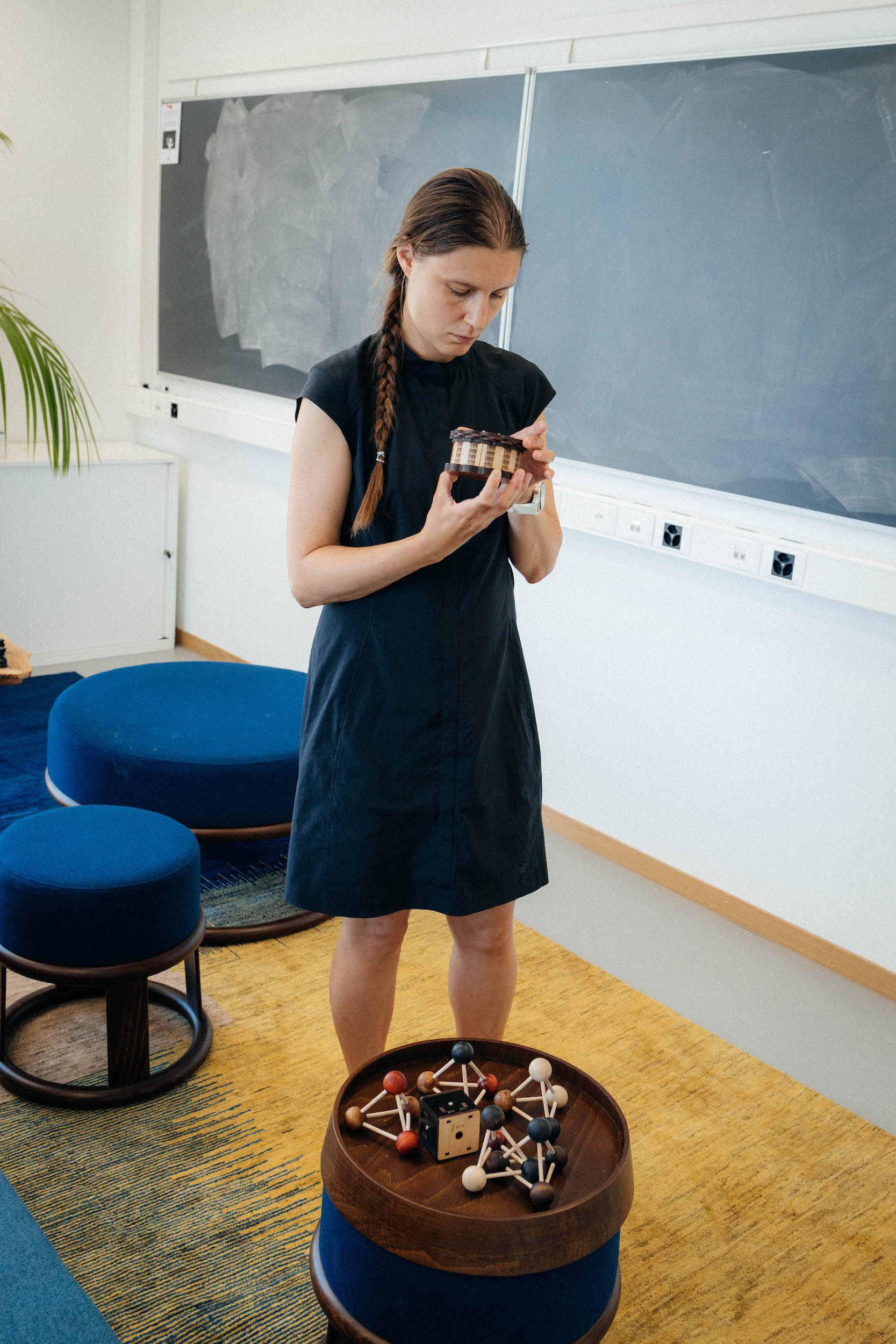
Ukrainian Scientist Maryna Viazovska Got Mathematics’ Top Award. We Discussed with Her how She Did It
The career of Maryna Viazovska, a 37-year-old Kyiv native, is typical for talented Ukrainian scientists. First, she studied in a maths school and took part in mathematical Olympiads. Having graduated from the Faculty of Mechanics and Mathematics of the Taras Shevchenko National University of Kyiv, she defended her dissertation and then went to Europe to pursue her endeavours in analytic number theory.
Six years ago, Maryna had a breakthrough in her career, solving the infamous sphere-packing problem — the one derived from the conjecture Johannes Kepler made 400 years ago — in dimension 8. The mathematical community recognized the scientist’s efforts with multiple awards, which culminated in her receiving the Fields Medal in early July and becoming the second woman to ever get it.
We talked to Maryna Viazovska to find out to what she had resorted to solve her dream problem, how differential equations save lives, and what can ruin a mathematician’s career.

Congratulations on the award. What do you feel about it?
It’s great when you get recognition. My highest expectation was to make it into the shortlist, so the medal came as a total surprise.
You solved the problem in 2016 but got the medal only now. What took them so long?
It is awarded once in four years. The previous congress took place in 2018. I don’t know their procedure, but I guess candidate screening takes time. The medal is awarded to scientists aged under forty. Last time, the organizers must have decided to give it to someone above thirty-six. It’s just my speculation, though.
So, what’s brewing in the field of mathematics these days?
Many things. New directions emerge, and every mathematician has to specialize.
Mathematics is a very diverse but still very conservative science. Some directions could be considered mainstream, like the Langlands programme in number theory in recent decades. It’s a robust system, a philosophy even, in which a fair number of questions remain open. Also, there are probability theory, analysis, and geometry, which has branches of its own.
Nevertheless, the field has an internal development logic that sometimes has little to do with external factors.

Do you mean that mathematics pays no attention to the problems of mere mortals?
Why, some directions may develop because of their practical significance, but that rarely happens. Take machine learning, for example. Everyone heard that a computer became so good at Go that it beats even the champions. But why did it happen? Is it because machine learning is a powerful tech or because people are bad at the game? This is where the mathematicians come in to find the answer or formulate the question in such a way that it can be answered and push the technology forward.
Nobody knows why machines are so good at the game of Go.
Some branches are more readily applicable. Several years ago, one colleague of mine specializing in differential equations was predicting tsunamis. It’s common knowledge that if an earthquake happens in the ocean, a tsunami will follow. However, oceans are complicated systems, and it’s hard to tell where the wave will strike. To answer this question, seismological stations all over the world are taking all kinds of measurements. As soon as an earthquake happens, a computer starts modelling its outcome, basically racing the wave, and the earlier the system makes a prediction, the better. A large part of this man’s career is finding new methods for analysing and quickly solving differential equations. Ocean wave movement is described by equations of this kind.
Did he teach the machine to better predict tsunamis?
The project did have some success. However, saying “he taught the machine” would be incorrect. Machines are just tools, and they shouldn’t be treated as humans.
Do you mean you didn’t even cry at the ending of Blade Runner?
I did. Wait — no, I didn’t. Frankly, I wasn’t that invested while watching it because I’m not into cyberpunk. Anyway, I don’t think the future as shown in that film is that inevitable.
So, there will be no machine uprising?
Now and then, I get context adverts offering me to meet beautiful 40-year-old Slavic women. Perhaps, the AI just doesn’t let me see how smart it is, but I don’t think it’s ready to overthrow humanity. It’s not the machines that we should fear but the people who use them to kill others. In this sense, the dark future is already here.
Let’s talk about the problem that you solved. You have found a formula to describe the most efficient way to stack spheres in dimension 24, haven’t you?
Not exactly. It’s more complicated than that. My work deals with two particular dimensions — 8 and 24 — and the sphere packing problem. Configurations for spheres in those dimensions have been known for a long time. The best configuration for dimension 8 was found back in the 19th century and for dimension 24 — more recently, in the 1960s.
Remember the tasks in the school geometry textbooks where you had to prove obvious statements? It was hard. And so, I proved an obvious statement that the E8 and Leech lattices are the best sphere configurations in dimensions 8 and 24, respectively, and nothing can be improved about them.
What are the dimensions in this context?
It’s just the number of coordinates in space. The 24-dimensional space encompasses all sets of 24 valid coordinates. You can have as many dimensions as there are numbers, which is indefinitely many.
Mathematicians would say that dimensions are a formality that has nothing to do with physical phenomena or human experience. Still, you can draw an analogy. Imagine an excel spreadsheet with various numbers in 11 columns — this is how a point in an 11-dimension space is described.


Did it take you two years to prove it?
In fact, it took more, but it was during those two years that I lived in Berlin that I really got down to work.
Working with a text, you understand more or less how much time you need to turn it into something acceptable. But how do you know how much time is left until you crack a mathematical problem?
You don’t. Imagine you intend to write not just a book but a bestseller. No matter how much time you invest, you won’t know for sure whether you will succeed or not until the last moment. The same thing with theorems. I mean, it’s still easier for writers — a lousy novel is still a novel. Meanwhile, an unproven theorem is something nobody wants.
Solving a problem is like writing a bestseller. You cannot know for sure if you will succeed.
Is that to say that you need be careful while picking a problem?
Yes, but scientists have some tricks. You can tackle a lot of more straightforward problems while working on your dream one. The result won’t surprise anyone, but it helps in writing an article. However, you shouldn’t overindulge in these small projects: invest everything in them, and you won’t ever tackle your primary problem. You need to maintain balance.
Is that what you did, too?
Yes, I had other projects.
How many times over those two years did you want to abandon the sphere-packing problem?
I didn’t. I’m an experienced mathematician, and I know how things are done. Besides, I don’t abandon the problems I’m trying to solve. Someone might come up with a solution while you still work on it, though. Competition is tough in mathematics.
What does working on a problem look like? Did you spend days at the blackboard writing formulas, erasing them, and then writing new ones?
That’s about it. I mean, it’s nothing exciting. In some aspects, it’s like working with texts: you sit down, write things, and then edit the bad out and leave the good in. I use a blackboard, a computer, and paper in equal measure for that.
When did you realize that the solution was close?
In the summer of 2015, I reached an important milestone and understood that I was about to finish. However, even then, it was crucial to stay alert — I had to wrap up many technical things, without which my solution would not have worked. I feared things could go awry even while publishing the paper.
How does it feel to finally solve the problem you have been working on for two years?
It’s pure ecstasy.

The Fields Award organization committee praised your solution for its elegance. Also, mathematicians are often talking about beautiful formulas. What sets a beautiful formula apart from a regular or ugly one, and what does it take for a solution to be considered elegant?
It’s all subjective, of course. In a formula, it’s the ratio between its conciseness and simplicity. “1 + 1 = 2” is simple but not that concise. Meanwhile, c2 = a2 + b2 — — the Pythagorean theorem — is beautiful, simple, and wholesome because it makes you think. Not everybody could discover it — it takes being a genius to do that.
Speaking of genius, Don Zagier was your research advisor in Germany. He finished school at thirteen and university at sixteen. At twenty, he got a
It was so exciting. Having an opportunity to meet people like him is a perk of being a mathematician. Don Zagier possesses extraordinary energy, ideas, and speed of thought. He can work 24/7, and his view of science and life is very intriguing. He often invites his students and the institute’s guests for lunch or dinner at a restaurant. And there’s always a piece of paper, a pen, and a lot of maths there, too. He doesn’t like idle talk and always cuts to the chase.
Looks like it’s easy to feel inept in the company of a person like him.
Interactions with Zagier inspired me to work more and somehow gave me hope that everything was solvable.
That said, studying at Max Planck Institute kinda ingrains certain modesty in you. You talk to Don Zagier, you meet
Studying at Max Planck Institute, you quickly become aware of your place in this world.
You have become the second woman to ever get the Fields Medal. You must have wondered why there are so few women among its laureates.
Sadly, we live in an imperfect world. It has its share of sexism and preconceptions, which hinder women’s ability to work productively. In some aspects, women face more difficulties than men — giving birth, raising children, etc. It’s hard to be a woman. However, I believe science needs more women.
Is there sexism in mathematics, too?
There certainly is. The mathematics community is a part of our society, after all.
Have you encountered any discrimination?
I met many people, and not all of them were kind to me. Some had preconceptions regarding female students and women in general. I was lucky, though: those were few and far between, and they had no decisive influence on my career.
academic degree awarded in some countries of Europe.
German mathematician specializing in arithmetic geometry, he is a laureate of the Fields Award as well as a holder of the Leibniz Prize — Germany’s highest distinction for scientific researchers.


Initially, this year’s Fields Award ceremony was to be held in Russia. However, the mathematicians wrote a collective letter demanding to move the congress to Helsinki. How did the mathematics community react to the Russian invasion of Ukraine?
The reaction varied from person to person and from country to country. However, the decision to cancel the congress in Russia was a good indication of the overall sentiment.
A few scientific societies in various countries openly condemned the aggressor’s actions. Many projects were launched to support Ukrainian students and scientists. I feel there is extensive support for Ukraine, at least in Europe, including among the academia.
Are there any supporters of Russia among big-name mathematicians?
It’s Russian mathematicians holding high offices in the Russian scientific administration. Also, Russia’s headline universities supported the war — their executives openly declared it. Some of them are mathematicians. However, there are no big names among them, as far as I know.
What were you up to after solving the sphere packing problem?
I kept working in the same direction and achieved some great results with my colleagues. We demonstrated that the E8 and Leech lattices are optimal not only for packing but also for minimizing energy — this is how good they are!
I also worked on corollaries of the method of my proof in the Fourier analysis and wrote a bunch of articles on interpolation. Now I work on geometrical optimization problems. However, they are yet unsolved, so I don’t really want to talk about them.
Are these problems comparable to those you solved in 2016 in terms of complexity?
It’s hard to tell. Still, solving the sphere packing problem in dimensions 8 and 24 does help me tackle what I’m working on now. Technically, they were pretty challenging, but I keep building on previous ideas in a way. These problems are very beautiful and important, too, so they need to be solved. I feel that it’s me who has to do it because others will have a harder time working on them.

Preparing for our interview, I discovered that the
If someone declares they have solved a problem, and then it turns out that their solution is incorrect — it’s a hit to their reputation. If a mathematician publishes nothing in twenty years, working on a hypothesis they can’t prove, they will be frowned at in the community, and for a good reason — instead of working on a subject where progress is achievable, the scientist wastes their time on a hopeless problem. This is the case of the Riemann hypothesis.
If a mathematician publishes nothing in twenty years, working on a hypothesis they can’t prove, they will be frowned at in the community.
And now the second one, have you considered tackling it?
No. I believe there is some danger to it. Moreover, there are many other problems in mathematics that are not as famous but equally complex and interesting. The Riemann hypothesis is a very niche thing, and I want more space for my work.
Still, if tomorrow I get an idea for a solution to the Riemann hypothesis, I would gladly tackle it. However, I lack ideas of this kind, and solving a hypothesis for its fame alone is a bad motivation. I want to work for another thirty or forty years, and I want to spend this time productively.
conjecture proposed by German mathematician Bernhard Riemann in 1859. It’s one of the most famous unsolved problems in modern mathematics.
Photo: Kseniya Marchenko exclusively for Bird in Flight
New and best






